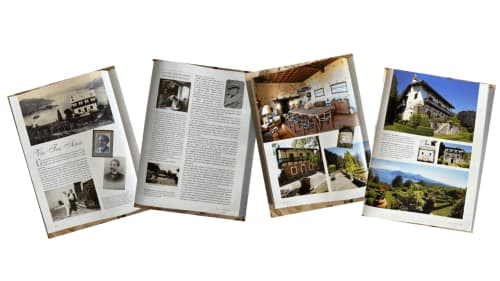

The historical background of the main house
Stresa also counts a very important musician among its illustrious guests: Giovanni Anfossi , descendant of Pasquale Anfossi, born on January 6, 1864 in Ancona and died on November 16, 1946 in Milan, where he studied composition and piano at the Naples Conservatory with Giuseppe Martucci studied; In 1887 he graduated with one of his compositions, “Ode to Love,” and the following year he won the piano chair at the Royal College of Verona. In 1894 he moved to Milan, where he founded and directed the “Pasquale Anfossi” music school, held the position of teacher at the Royal Female College and the Bruni Morandi Institute, and was for many years examiner at the prestigious Verdi Conservatory. He is one of the best masters of music and piano, under whose guidance Arturo Benedetti Michelangeli and Luisa Baccara were trained.
Giovanni and his wife Tina were vacationing above Stresa, in the Alpino area, in a villa that belonged to them and was built between 1907 and 1908 . The building still has a certain architectural and historical significance, as Andrea Lazzarini explains: “The completed project of the building, designed by the famous architect Giuseppe Bagatti Valsecchi (Milan 1845 - Milan 1934), takes up the classic style of Lombardy of the 16th century, which included the use of granite, stone and wood as well as extensive exterior decoration. The house, which consists of a single body extending over two floors, has an austere appearance and is embellished only by the window frames, the wooden columns that support the eaves and the balcony, also made of wood. The interiors are designed in the Renaissance style, with windows made of Venetian leaded glass, the walls are finely decorated with the monogram AT (Alpe Tina) and a stylized sun.
The house preserves a Latin epigraph dictated by the Archbishop of Milan Achille Ratti , later Pope Pius, "Qui tutto e musica, ed il compito del maestro e quello di tradurre in note la voce superba delta natura " ("Here all is music, and the master’s task is to translate the beautiful voice of nature into notes”). On the lake side of the residence you can read the Latin motto: “Parva Domus, Magna Quies ” (small house, great peace). Villa Anfossi is also known as “Alpe Tina” because it was built on a mountain pasture and dedicated to Tina, the wife of maestro Giovanni Anfossi, with whom he was madly in love throughout his life.
The villa became the meeting point and accommodation for many people and personalities linked to the fine arts, literature, music and Milanese and international social life and exchanges. From great musicians such as Arturo Toscanini, Guido Cantelli, Ruggero Leoncavalli to Maestro Anfossi's favorite student, Arturo Benedetti Michelangeli , to the famous writer, poet and politician Gabriele D'Annunzio , with whom he maintained an intensive correspondence. The correspondence between Anfossi and D'Annunzio could be traced back to Luisa Baccara, who was not only a student of Anfossi, but also the lover of the poet D'Annunzio
There are numerous compositions by Giovanni Anfossi, almost all for piano, including: Water Games, Vermilion Vision, Green Sensation, Blonde Vision, Among the Flowers: Question and Answer.









